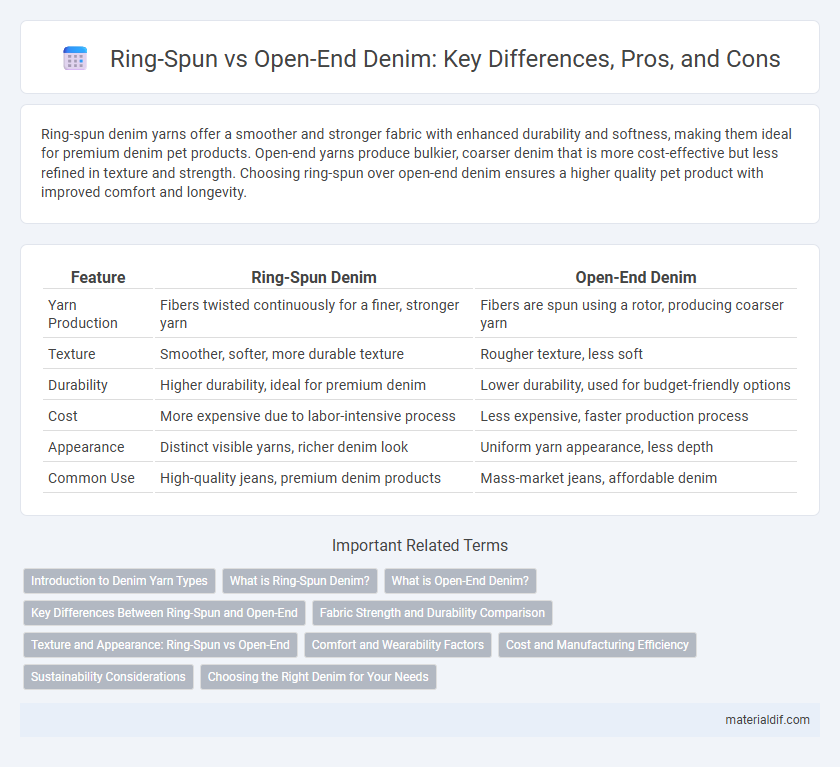Ring-spun denim yarns offer a smoother and stronger fabric with enhanced durability and softness, making them ideal for premium denim pet products. Open-end yarns produce bulkier, coarser denim that is more cost-effective but less refined in texture and strength. Choosing ring-spun over open-end denim ensures a higher quality pet product with improved comfort and longevity.
Table of Comparison
| Feature | Ring-Spun Denim | Open-End Denim |
|---|---|---|
| Yarn Production | Fibers twisted continuously for a finer, stronger yarn | Fibers are spun using a rotor, producing coarser yarn |
| Texture | Smoother, softer, more durable texture | Rougher texture, less soft |
| Durability | Higher durability, ideal for premium denim | Lower durability, used for budget-friendly options |
| Cost | More expensive due to labor-intensive process | Less expensive, faster production process |
| Appearance | Distinct visible yarns, richer denim look | Uniform yarn appearance, less depth |
| Common Use | High-quality jeans, premium denim products | Mass-market jeans, affordable denim |
Introduction to Denim Yarn Types
Denim yarn types primarily include ring-spun and open-end yarns, each affecting the fabric's texture and durability. Ring-spun yarns are made by continuously twisting fibers, resulting in a finer, stronger, and softer yarn ideal for premium denim. Open-end yarns are produced using a faster spinning process that creates a coarser and thicker yarn, often used for more affordable, rugged denim products.
What is Ring-Spun Denim?
Ring-spun denim is crafted using yarns spun on a ring frame, which twists and thins the cotton fibers to create a finer, stronger, and more durable thread compared to open-end spun yarns. This spinning method results in a softer texture, higher tensile strength, and better dye absorption, contributing to the premium quality and longevity of ring-spun denim fabrics. Widely used in high-end denim jeans, ring-spun denim offers superior comfort and a more refined appearance, making it a preferred choice for denim enthusiasts and designers.
What is Open-End Denim?
Open-end denim is produced using an open-end spinning process that twists shorter cotton fibers into yarn, resulting in a thicker, coarser texture compared to ring-spun denim. This manufacturing technique offers higher production speed and cost efficiency, making open-end denim a popular choice for casual, durable jeans. The fabric typically displays a rougher surface with less uniformity, contributing to its unique rugged aesthetic favored in workwear and streetwear styles.
Key Differences Between Ring-Spun and Open-End
Ring-spun denim yarn is produced by continuously twisting and thinning the cotton fibers, resulting in a finer, stronger, and more durable fabric with a softer feel. Open-end denim yarn is manufactured through a faster, mechanical process that produces coarser, less flexible fibers, leading to a rougher texture and lower tensile strength. These key differences affect the quality, price, and overall durability of denim garments, with ring-spun denim often preferred for premium and long-lasting apparel.
Fabric Strength and Durability Comparison
Ring-spun denim yarns exhibit superior fabric strength and durability compared to open-end denim due to their tightly twisted fibers, which enhance tensile strength and abrasion resistance. Open-end denim, while more cost-effective and quicker to produce, typically has lower fiber cohesion, resulting in a softer but less durable fabric that wears out faster under stress. Manufacturers prioritize ring-spun denim for premium, long-lasting garments targeted at consumers seeking high-performance durability.
Texture and Appearance: Ring-Spun vs Open-End
Ring-spun denim features finer, stronger yarns with a soft, smooth texture and a distinct, durable appearance due to tightly twisted fibers. Open-end denim uses coarser, bulkier yarns, resulting in a rougher texture and a more rugged, less refined look. The choice between ring-spun and open-end impacts the fabric's feel, visual detail, and overall quality perception.
Comfort and Wearability Factors
Ring-spun denim features tightly twisted yarns that enhance fabric softness and durability, providing superior comfort during prolonged wear. Open-end denim employs a faster production method resulting in coarser yarns, which may offer less breathability and flexibility. Choosing ring-spun denim improves wearability through greater fabric resilience and a smoother texture, ideal for everyday comfort.
Cost and Manufacturing Efficiency
Ring-spun denim offers higher quality and durability but involves longer production times and increased labor costs compared to open-end denim, which is manufactured faster and at a lower cost due to its simpler spinning process. Open-end spinning produces yarn with a coarser texture, reducing material costs but sacrificing the finer feel and strength of ring-spun yarn. Manufacturers often balance cost-efficiency and fabric quality by selecting open-end for budget-friendly denim and ring-spun for premium, durable apparel.
Sustainability Considerations
Ring-spun denim is generally more sustainable due to its longer fiber usage, resulting in less waste and improved fabric durability compared to open-end denim, which consumes more energy and produces more waste during the spinning process. Open-end spinning, while faster and cheaper, often relies on lower-quality fibers that reduce the garment's lifespan, increasing environmental impact over time. Choosing ring-spun denim supports eco-friendly production by enhancing fabric strength and reducing resource consumption in both manufacturing and garment lifecycle.
Choosing the Right Denim for Your Needs
Ring-spun denim delivers superior softness and durability due to tightly twisted yarns, making it ideal for high-quality, long-lasting jeans. Open-end denim, produced through a faster and more cost-effective process, offers a rougher texture and is suitable for budget-friendly, casual wear. Selecting the right denim depends on balancing quality demands with budget constraints and intended garment use.
Ring-spun vs open-end Infographic

 materialdif.com
materialdif.com